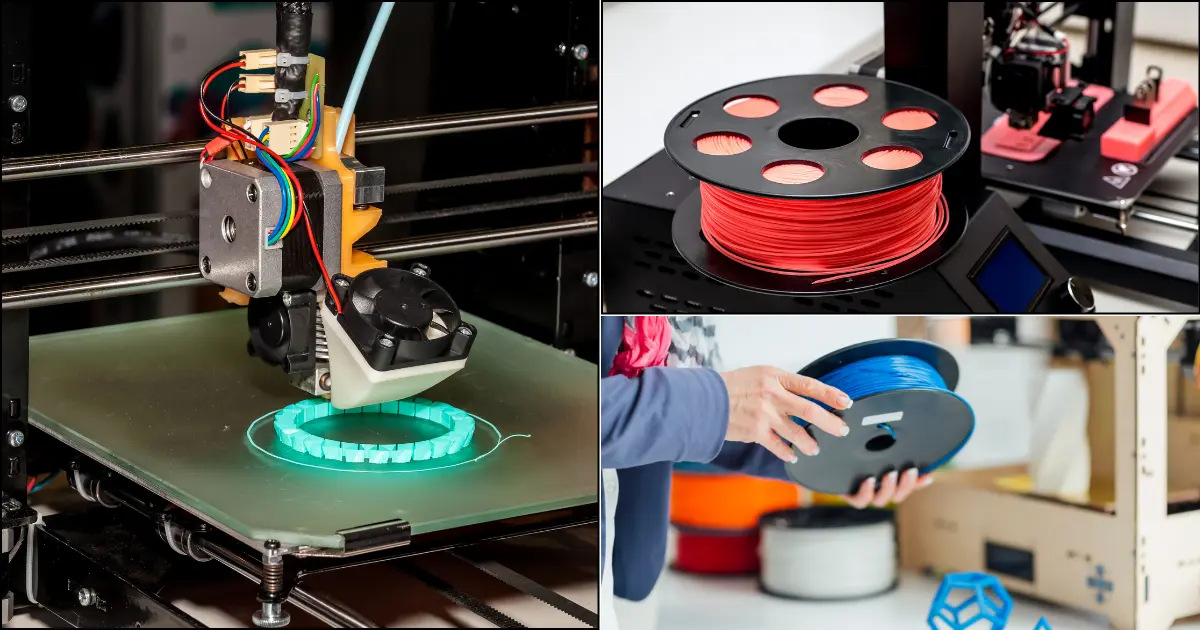Welcome to the exciting world of 3D printing! Whether you’re a beginner, a seasoned enthusiast, or a DIY maker, understanding the different types of 3D printer filaments is crucial for creating successful and high-quality prints. In this guide, we’ll walk you through the essential 3D printer filaments, their uses, and how to choose the right one for your projects.
Table of Contents
Understanding 3D Printer Filaments

3D printer filaments are the materials used in Fused Deposition Modeling (FDM) 3D printers. Think of them as the “ink” in your printer, where different filaments offer various properties, colors, and strengths, allowing you to create everything from simple prototypes to intricate art pieces.
Top Types of 3D Printer Filaments
PLA 3D Printer Filament 1.75 mm
Polylactic Acid (PLA) is one of the most popular filaments, especially for beginners. It’s biodegradable, derived from renewable resources like corn starch, and offers ease of use with minimal warping.
- Advantages:
- Easy to print
- Low warping
- Wide color range
- Uses:
- Prototyping
- Educational projects
- Decorative items
ABS Filament
Acrylonitrile Butadiene Styrene (ABS) is known for its strength and durability. It’s commonly used in manufacturing and engineering due to its resistance to high temperatures.
- Advantages:
- Strong and durable
- Heat-resistant
- Recyclable
- Uses:
- Functional parts
- Mechanical components
- Automotive parts
PETG Filament
Polyethylene Terephthalate Glycol (PETG) combines the ease of PLA with the strength of ABS. It’s less prone to warping and is food-safe under certain conditions.
- Advantages:
- Durable and flexible
- Low warping
- Food-safe (with proper certification)
- Uses:
- Functional prototypes
- Bottles and containers
- Outdoor applications
TPU Filament
Thermoplastic Polyurethane (TPU) is a flexible filament, perfect for creating items that require elasticity and impact resistance.
- Advantages:
- Highly flexible
- Impact-resistant
- Wear-resistant
- Uses:
- Phone cases
- Wearable items
- Seals and gaskets
Nylon Filament
Nylon is celebrated for its strength, flexibility, and durability. It’s ideal for creating parts that must withstand stress and wear.
- Advantages:
- Strong and durable
- Flexible
- Wear-resistant
- Uses:
- Mechanical parts
- Gears and hinges
- Functional prototypes
Specialty Filaments
Beyond the standard filaments, there are specialty options like wood-infused, metal-infused, and glow-in-the-dark filaments, catering to specific aesthetic and functional needs.
Special Features in Filaments
Dishwasher Safe 3D Printer Filament
Certain filaments are designed to withstand high temperatures, making them safe for dishwasher use. Polycarbonate (PC) and PETG are examples that can endure the heat and moisture of a dishwasher without degrading.
- Benefits:
- Easy to clean
- Suitable for kitchenware
- Considerations:
- Ensure filament is certified dishwasher safe
- Check printer nozzle compatibility
Iridescent 3D Printer Filament
Iridescent filaments add a sparkling, rainbow-like effect to your prints, making them perfect for decorative items and artistic projects.
- Benefits:
- Unique visual appeal
- Adds shimmer and sparkle
- Considerations:
- May require precise printing settings
- Can be more challenging to print with due to additives
Choosing the Right Filament
Selecting the right filament depends on your project’s requirements, printer compatibility, and desired finish. Here’s how to make an informed decision:
Diameter Matters: 1.75 mm vs. 3 mm
Filaments come in different diameters, with 1.75 mm being the most common, especially for hobbyist and beginner printers. 3 mm filaments are typically used in industrial settings.
- 1.75 mm 3D Printer Filament:
- More flexible in feeding
- Generally lower printing temperatures
- 3 mm 3D Printer Filament:
- Often used in larger-scale printers
- Can be more rigid
Compatibility with 3D Printer Nozzles
Ensure that the filament’s diameter matches your printer’s nozzle specification. Additionally, some filaments may require a ruby 3D printer nozzle for enhanced durability, especially when printing abrasive materials like metal-infused filaments.
- Ruby Nozzles:
- Highly durable
- Suitable for abrasive filaments
- Standard Nozzles:
- Adequate for most standard filaments
Buying Guide: What to Look For
When purchasing filament, consider the following factors to ensure you get the best quality and performance:
- Material Type: Choose based on your project’s needs (e.g., PLA for ease, ABS for strength).
- Diameter: Ensure compatibility with your printer (commonly 1.75 mm).
- Quality: Look for consistent diameter and color.
- Brand Reputation: Opt for reputable brands to avoid printing issues.
- Price: Balance cost with quality; cheaper filaments may cause more printing problems.
- Special Features: Such as abrasiveness, flexibility, or finish (e.g., iridescent).
Maintenance Tips for Your 3D Printer Filaments
Proper storage and handling can extend the life of your filaments and ensure high-quality prints.
- Store in Dry Conditions: Use airtight containers with desiccants to prevent moisture absorption.
- Handle with Care: Avoid tangling and exposure to direct sunlight.
- Regular Cleaning: Keep your printer’s nozzle clean to prevent clogs from filament debris.
Conclusion
Choosing the right 3D printer filament is essential for the success of your projects. From the beginner-friendly PLA 3D printer filament 1.75 mm to the specialized dishwasher safe filament, understanding each type’s properties and uses will help you make informed decisions. Always consider your project’s requirements, printer compatibility, and filament quality to achieve the best results. Happy printing!



















What do you think?
Show comments / Leave a comment